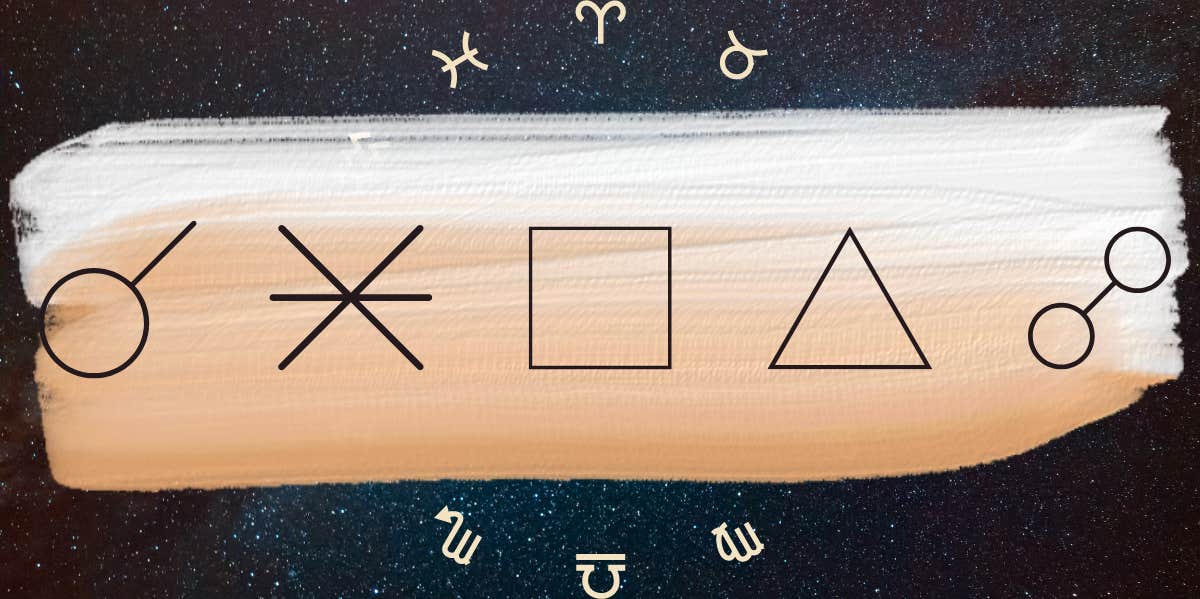A Guide To The Major Aspects In Astrology — And What They Mean For Your Life
It's not just the stars and moon that guide us.
 Canva Creative Studio, Design & Beyond, Jessica Aceret, ponizeothox via canva
Canva Creative Studio, Design & Beyond, Jessica Aceret, ponizeothox via canva Astrology is broken up into numerous planetary aspects defined by the mathematical degree of separation between two planets.
Oftentimes, we split them into two groups, minor and major astrology aspects, though in astrology this is the difference between having a pebble in your shoe versus a stone — just because one is bigger or more obvious doesn’t mean that small pebble (or minor aspect) won’t be noticeable.
While the minor aspects of astrology represent our internal world and changes that occur to our emotional and mental, the major aspects in astrology tend to deal more with our actions, choices, and things that impact our physical world.
This means that while we might have personality clashes, feeling changes, or moments of epiphanies with the minor aspects, it likely will stay just that, whereas the major aspects are what propel us forward into growth, so it’s not only our internal world that looks different but our outer world as well.
What are the Major aspects in astrology?
1. Conjunction
A conjunction means that two or more planets are within 10 degrees of one another, essentially blending their energies. When this happens, depending upon the planets affected, we could see great benefit to our own lives.
For instance, if a conjunction of Mars and Venus occurred, we could feel a greater motivation to go after what we truly love.
Usually speaking, there isn't a bad side to this aspect; however, depending on different factors — such as other transits, or even our own personal mental state — we could see challenges around this blending of energies.
2. Sextile
A sextile is defined as two planets that are within 60 degrees of one another, creating positive energy and circumstances that can lead to growth.
Because this is one of the major aspects in astrology, this opportunity will lead to actual physical manifestations and direction changes within our lives.
This is the point at which we are given a chance or decision to speak our truth, and because of that, we act in our own lives. This can look like a job offer, a chance to move, or even someone wanting to pursue things romantically.
But the sextile also connects to past karma and tells us that the opportunities we get to deal with (or enjoy) are those that we previously planted the seeds for with our prior decisions and behavior.
There's no negative or challenging energy with this transit, but that doesn’t necessarily mean it will translate to being easier, either.
3. Square
Everyone dreads this aspect because it can be challenging. But squares are also necessary.
A square is defined by two planets being within 90 degrees of one another, which creates a stressful aspect. But this is also the moment of climax, the point at which during a movie where all seems lost and we’re wondering what will happen next. A square builds that tension so that action has to be taken, one way or another. We get to choose.
A square also shows us that if we don’t take action, that doesn’t mean some kind of action won’t be taken. This is an excellent transit for getting things done or breaking up our stagnancy in all areas of our lives, even if it seems a bit scary at first.
4. Trine
A trine is defined by two planets that are within 120 degrees of one another, which creates a positive and beneficial aspect. This is because they’ve essentially teamed up to take on one obstacle together, which means that we can find greater success in our lives and even greater peace.
For instance, if there was a trine between Uranus and Mars, it would enable us to pursue the changes we needed to incorporate into our lives so we could have a more favorable outcome.
This is a great transit for give-and-take, meaning that we can also experience more balance in whatever we’re working through, as well as ourselves.
5. Opposition
An opposition transit is exactly what it sounds like. This is when two planets in two different signs are opposite or at odds with one another, classically defined as being 180 degrees apart.
With this transit, balance is not given like it is with a trine; in fact, it's more likely to make us more aware of what isn’t in balance overall. This will look like a tug of war or being pulled between two ideas or options in life.
Many times, when faced with an opposition, it’s actually a moment of immense growth in which we’re being asked to look at how we did things, and how we want to do them now.
In this case, the opposing effect of this transit can also lead us to dialogue, healing, and discussing what the issue is with others (specifically, a romantic partner) so we can build a greater sense of balance together.
Kate Rose is an artist, writer, passionate yogi, spiritual astrologist, relationship and life coach, and motivational speaker. As a spiritual intuitive, she practices the religion of astrology and love. For more of her work, visit her website.
